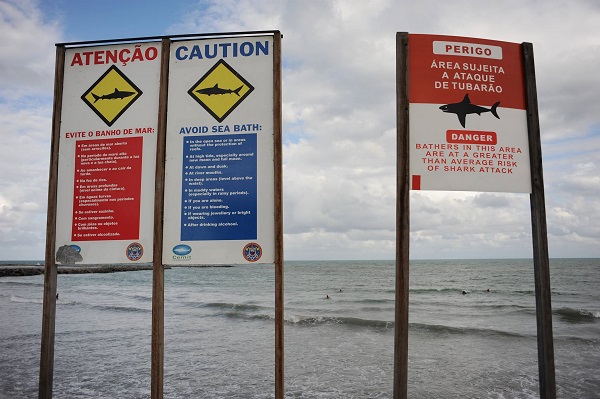The first step in shark attack prevention is understanding the risk. When you enter the water, you are visiting the shark’s home and dropping down a notch on the food chain. Statistics show that you are more likely to die from drowning than be killed by a shark.

However, sharks do bite/attack people and there are things you can do to avoid potential danger.
Shark attack prevention tips
1.Do not go into the water if you see a shark.
2.Know the area. Ask lifeguards or locals if sharks have been spotted in the area and check the Dorsal shark reporting app and check for shark sightings.
3. Do not go in the water if you are bleeding. Human blood does not appear to be a direct attractant to sharks, however the unique smell could attract a sharks attention.
4. Do not swim or enter the ocean during low light. Some sharks may be more active at night, dawn, and dusk, plus their vision could be impaired by the low light.
5. Avoid swimming near river mouths that meet with the oceans waters. Bull sharks are known to feed in these areas and the water may be murky.
6. Avoid swimming in murky water. Sharks hunt using a variety of senses including sight. If they sense your presence but can’t see you, they may come to investigate which could cause a negative interaction.
7. Avoid swimming after storms when the water may be murky. After storms also avoid swimming near where rivers drain into the ocean. Dead animals may have been carried downstream and into the ocean, which could attract sharks.
8. Avoid wearing yellow colored bathing suits. The term yum-yum yellow has been used to describe yellow neon bathing suits that appear to attract sharks. Bright colors pop in murky water and can draw a shark’s attention.
9. Avoid wearing shiny jewelry. The sparkle of a jewel or chain may resemble fish scales to a predator. (Brightly colored tattoos may also attract sharks to investigate.)
10. Use even strokes when swimming. Lots of splashing could sound like an injured fish to a shark.
11. Swim in groups close to shore away from drop offs in the water. Including between sandbars.
12. If you see bait fish or birds diving in the water, swim away and towards the shore as quickly and calmly as possible. Sharks may be feeding.
13. Do not swim with seals or sea lions, they are prey for sharks, or swim around fishermen. Their bait could attract sharks.
14. If you see a shark, leave the water as quickly and calmly as possible.
15. Use your intuition. If you have a bad feeling, leave the water.
16. If you are an avid surfer or diver, consider purchasing a shark deterrent device and OMNA tourniquet surf leash.
17. Snorkelers and divers are advised to stay in groups, dive in areas with good visibility and scan their surroundings frequently. When possible, ask someone monitor those in the water from a boat or other high platform. Not only can this help with a potential shark encounter, but raises awareness should anyone become separated from the group or pulled away by currents.
18. Excursion operators should carry tourniquets, first aid kits and have an emergency plan in place. Once on board, visitors should be informed of the locations of the items through a safety briefing.

Being attacked or bitten by a shark
While the majority of people bitten by sharks never saw the shark coming, there are some things you can do should you come face to face with a shark.
1. Call for help. Alerting others can speed up medical services and rescue efforts.
2. Prepare to fight. Most sharks are not use to prey fighting back.
3. Face the shark. Keep an eye on it as you slowly swim to shore.
4. If you see a shark is acting aggressively and you believe a bite is imminent, you may choose to fold your non-dominate arm into a V shape with your wrist facing toward your bicep (to protect your arteries) aiming your elbow directly at the shark. Should the shark bite your arm, then it will be biting across two bones.
5. Hit, rip, poke, and tear at the sharks eyes and gills. Both are sensitive areas. Continue until the shark leaves. A shark’s snout is sensitive, but due to the angle of head, a punch could end up sliding directly into the shark’s mouth.
6. Alert other beachgoers to what has happened and seek medical attention (even a small bite could lead to infection). Surfboard leashes can be used as makeshift tourniquets.
7. Stop the bleed by applying pressure to the wound or pressure point. If a leg is injured, make a fist and use your body weight to press hard between the thighs and genitals (between the hips and bits) to slow the bleed.
Understanding a shark attack or bite
The state of Florida has the highest number of negative shark interactions in the world and considered the shark attack capitol of the world. However, the use of the term shark attack is not 100% accurate.
The majority of shark attacks in the state would be better defined as shark bites. The reason behind this is that most of the interactions involve a one off bite also called a hit and run. The theory is that the shark confuses a human with prey, takes an exploratory bite, realizes the human is not prey and then leaves.
There are very few deaths in the United states as the majority of encounters are single bites from small sharks. While a bite from a small blacktip shark may be minor, a bite from a large white or tiger shark could be fatal. The larger the shark is, the more damage it can inflict.
Another issue to be considered is the species of shark. While even normally docile sharks, even nurse sharks have been known to bite when provoked, they cause very little damage.
Deadliest sharks
The majority of sharks species are harmless, but there are three man shark species that can be a serious threat to life and limb.
Bull sharks have been filmed aggressively approaching divers and may charge humans in an effort to size us up.

Tiger sharks will eat anything, including humans. They are known as the trash cans of the sea and have been found with all sorts of debris in their bellies, including metal objects and tires.
Adult whites sharks have a massive bite radius with large teeth. Even a test bite from such a large predator can be fatal.
Keep in mind that this list is not all encompassing, however those three species should be avoided by swimmers and surfers at all costs.
While the thought of a shark attack is very frightening, the reality is water itself is the real killer.
According to the Center for Disease Control “From 2005-2014, there were an average of 3,536 fatal unintentional drownings (non-boating related) annually in the United States — about ten deaths per day.” More people are killed by cows than by sharks.
This is not to say shark’s are not dangerous. They are predators and like any wild animal they should not be harassed or molested.
While this article suggests some things you can do to aid in shark attack prevention, always use your best judgement when entering the water. Most importantly if you do encounter a shark, do not attempt to touch it, unless you are defending yourself or others.